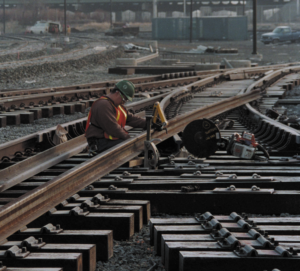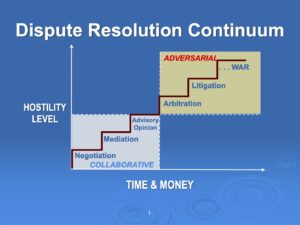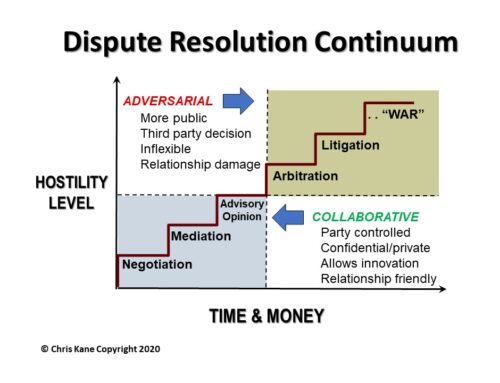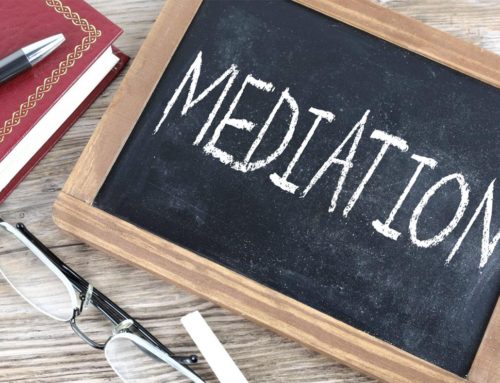A recent article in The VIRGINIA LAWYER MAGAZINE (April 2021), is entitled “Going Off The Rails with the Purple Line: Lessons in Project Delivery and Risk Management“. The authors Jeff Gilmore, John Neary and Daniel Miktus, give a concise summary of what went wrong on this major P3 light rail transit project in Maryland. They describe a number of delays on the Project that were ultimately the primary drivers to the termination of the P3 design-build contract. Compounding these delays however are what the authors call “Inefficient Dispute Resolution”, including: 1) too few conditions precedent to file a claim; 2) use of a dispute review board was made optional, not mandatory, and; 3) the time frame for the contracting officer and the State to review claims was very lengthy, with 6 months to review appeals. Regardless of what went wrong and why, I wanted to reflect on my experience of what makes for an “efficient dispute resolution” for mega-projects like this.
describe a number of delays on the Project that were ultimately the primary drivers to the termination of the P3 design-build contract. Compounding these delays however are what the authors call “Inefficient Dispute Resolution”, including: 1) too few conditions precedent to file a claim; 2) use of a dispute review board was made optional, not mandatory, and; 3) the time frame for the contracting officer and the State to review claims was very lengthy, with 6 months to review appeals. Regardless of what went wrong and why, I wanted to reflect on my experience of what makes for an “efficient dispute resolution” for mega-projects like this.
Early Dispute Resolution
An “efficient dispute resolution” process is no different than how we avoid major problems with our cars or homes or any other critical functioning asset. The key to is to use both a “preventive maintenance” program, as well as insuring “early repairs” when inevitable problems arise. Participants on mega-projects, need to think first of “preventive maintenance” in their project agreements when developing their risk management approach. Partnering and team building, as well as progressive contracting are important elements of preventive maintenance and dispute avoidance. Project agreements should also incorporate one or more methods of resolving disputes in a timely collaborative manner, with the help of a neutral when needed. The dispute resolution continuum in Figure 1, indicates preferred methods to resolve disputes. As indicated, collaborative methods (lower left quadrant) save time and money as well as preserving business relationships. Stepped negotiations, mediation, and non-binding advisory opinions (especially use of dispute review boards) are the primary methods of efficient dispute resolution described below.
Figure 1
Partnering and Team Building – In an effort to minimize the difficulties often encountered on mega-projects, participants need to implement a comprehensive approach to building collaborative relationships based on open communication and trust. The foundation for successful projects requires relationships spelled out in well-drafted contract documents with equitable and realistic risk allocation. But successful working relationships depend on much more than the contracts. Team building on construction projects requires a concentrated effort to establish collaborative working relationships as opposed to the traditional adversarial relationships. Key elements of a comprehensive team-building approach include structured partnering workshops, constructibility reviews and use of incentives. The partnering effort must continue throughout the project and is best insured by investing in a experienced third party facilitator.
Multi-Stepped Negotiation Process – The industry’s best practices for project agreements include some element of multiple stepped negotiations, starting at the lowest possible level and the earliest point in time. This is the first level of effort to avoid or resolve the dispute. Imposing time limits for negotiations and providing various levels of escalation (project managers, senior executives, and/or CEOs) provides two pressure points on negotiators that work well together. The time deadlines require the individuals at that level to meet and conclude the negotiation effort in a limited time. The escalation pressure means that if the individuals are not successful, their bosses will be asked to fix the problem. Once the negotiations process reach an impasse, the steps should immediately continue with the help of a neutral.
Mediation – As with other collaborative processes, mediation is well suited for early resolution, least cost and best outcome solutions. Mediation is a confidential and non-binding method of dispute resolution, involving a neutral third party skilled in assisting the parties in finding a their own mutually acceptable resolution. My experience with mediation has proven early involvement in mediation can greatly mitigate the problems, time and expense that disputes can cause to a project. On a recent case the early involvement of the mediator prior to project completion, avoided a nearly certain termination and ended up resolving all the issues. Zoom helps do this in a timely manner. By using mediation, the parties can remain in complete control of the resolution of their dispute, fashion a settlement that satisfies their individual interests, and achieve potential creative “mutual gains” that are also best-for-project.
Non-Binding Advisory Opinion – The use of a non-binding advisory opinion from an expert neutral can be a cost effective, real time method to resolve disputes. This process has some advantages over both mediation (which often is not an evaluative process) and binding arbitration (which often is more adversarial, expensive and time consuming). The advisory opinion process can be completed in less than 90 days. The Dispute Review Board (DRB) Foundation has a very sound and proven framework for real time advisory opinions. DRBs meet regularly and give non-binding opinions on disputes as they arise during the course of the project. DRBs normally consist of a 3 member panel with a member chosen by each party, and the 2 party members choosing the chair. DRBs can be a powerful tool in promoting collaborative dispute avoidance and dispute resolution, but they should include a required process throughout the project.
Arbitration, Using Concurrent Mediation – When you consider the fact that over 95% of civil lawsuits settle before trial, and probably over 50% of arbitrations settle before an award, it is hard to justify completely turning cases over to arbitration, and abandoning negotiations. It makes a lot of sense after impasse to continue the availability of mediation, while the arbitration process is proceeding. Different stages of the case may produce opportunity for settlement and the original mediator can be on stand by to help. The International Institute for Conflict Prevention & Resolution developed a model clause and protocol for concurrent mediation and arbitration where the parties can continue to attempt to settle any dispute by confidential mediation conducted during the pendency of the arbitration. This method provides a continuing venue for settlement negotiations that provide a much earlier off-ramp, saving time and money.
As we move into a period of critical rebuilding, renewing and reinventing our country’s infrastructure, we need to ensure preventive maintenance and early dispute resolution are built into our contracting structures, especially for our mega-projects. The return on investment from this is enormous, when a major project conflict, or worse yet a termination, can be avoided. All the participants and stakeholders to these projects need to commit to invest the time, money and dispute resolution expertise in planning for and implementing “efficient dispute resolution” in their project agreements, in order to make this happen.





